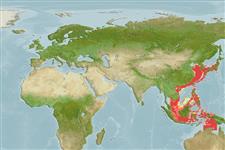Common names from other countries
>
Scombriformes (Mackerels) >
Scombridae (Mackerels, tunas, bonitos) > Scombrinae
Etymology: Scomberomorus: Latin, scomber = mackerel + Greek, moros = silly, stupid (Ref. 45335).
More on author: Lacepède.
Environment: milieu / climate zone / depth range / distribution range
Ecología
marino; agua dulce; salobre; anfidromo; rango de profundidad 10 - ? m. Subtropical; 41°N - 14°S, 102°E - 140°E (Ref. 168)
Western Pacific: Akita, Honshu, Sea of Japan, Yellow Sea and China south to Vietnam and Cambodia where it enters the Mekong River.
Tamaño / Peso / Age
Maturity: Lm ? range ? - ? cm
Max length : 247 cm TL macho / no sexado; (Ref. 83530); common length : 100.0 cm TL macho / no sexado; (Ref. 27773); peso máximo publicado: 131.00 g (Ref. 83530)
Espinas dorsales (total): 15 - 17; Radios blandos dorsales (total): 15-17; Espinas anales 0; Radios blandos anales: 16 - 19; Vértebra: 41 - 42. Interpelvic process small and bifid. Body covered with small scales. Lateral line abruptly curving down below first dorsal fin. Intestine with 2 folds and 3 limbs. Swim bladder present. Sides silvery with large round, indistinct spots in two poorly defined rows in adults. Juveniles with saddle-like blotches extending down to about middle of body.
Travels 300 km up the Mekong River, above Phnom Penh but believed to reproduce only in marine waters. Feeds on fishes and swims well upstream river because of easy food availability (Ref. 12693). No information on biology available (Ref. 9684). It is a prized food fish in Japan and probably in China as well. Utilized fresh, dried or salted and smoked; consumed pan-fried, broiled and baked (Ref. 9987).
Life cycle and mating behavior
Madurez | Reproducción | Puesta | Huevos | Fecundidad | Larva
Collette, B.B. and C.E. Nauen, 1983. FAO Species Catalogue. Vol. 2. Scombrids of the world. An annotated and illustrated catalogue of tunas, mackerels, bonitos and related species known to date. Rome: FAO. FAO Fish. Synop. 125(2):137 p. (Ref. 168)
IUCN Red List Status (Ref. 130435)
CITES (Ref. 128078)
Not Evaluated
Threat to humans
Harmless
Human uses
Pesquerías: comercial; pesca deportiva: si
Más información
ReferenciasAcuiculturaPerfil de acuiculturaRazasGenéticaElectrophoresesheritabilidadEnfermedadesProcesamientoMass conversion
ColaboradoresImágenesStamps, Coins Misc.SonidosCiguateraVelocidadTipo de nataciónSuperficie branquialOtolitosCerebrosVisión
Herramientas
Special reports
Download XML
Fuentes de Internet
Estimates based on models
Preferred temperature (Ref.
115969): 11.9 - 28.3, mean 26.6 (based on 719 cells).
Phylogenetic diversity index (Ref.
82804): PD
50 = 0.5000 [Uniqueness, from 0.5 = low to 2.0 = high].
Bayesian length-weight: a=0.00832 (0.00383 - 0.01808), b=3.03 (2.86 - 3.20), in cm Total Length, based on LWR estimates for this Genus-body shape (Ref.
93245).
Nivel trófico (Ref.
69278): 4.5 ±0.80 se; based on food items.
Resiliencia (Ref.
120179): Bajo, población duplicada en un tiempo mínimo de 4.5-14 años (Preliminary K or Fecundity.).
Fishing Vulnerability (Ref.
59153): Very high vulnerability (90 of 100).
